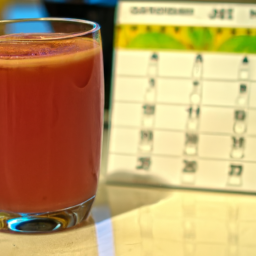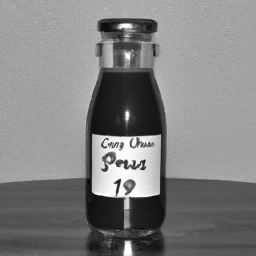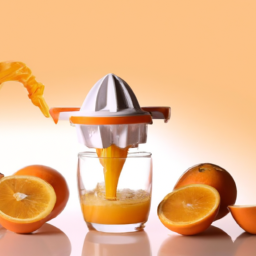As someone who is passionate about maintaining a healthy lifestyle and eating nutritious foods, I often reach for a glass of freshly squeezed juice. The vibrant colors and delicious flavors of juice made from fresh fruits and vegetables always make me feel nourished and energized.
But as I’ve learned over the years, not all juices are created equal – and one of the most important factors to consider is how long the juice is good for.
In this article, I’ll be diving into the science behind the shelf life of fresh pressed juice, including the factors that affect it, how to tell if your juice has gone bad, and tips for maximizing its shelf life.
Whether you’re a juice enthusiast or simply curious about the world of fresh pressed juice, this article will provide you with a comprehensive guide to understanding how long your juice will last and how to store it properly.
Key Takeaways
- Fresh pressed juice typically lasts for 3-5 days in the fridge, but this can vary depending on factors like temperature, type of produce used, and exposure to light.
- To extend the shelf life of fresh pressed juice, store it in an airtight container in the fridge and consume it within 3-5 days.
- Freezing fresh pressed juice can help preserve its nutrients and flavor, but it should be poured into an airtight container and consumed within 3 months.
- Drinking expired fresh pressed juice can lead to adverse health effects, so it’s important to store and consume it properly.
Understanding the Shelf Life of Fresh Pressed Juice
Freshly pressed juice typically lasts for 3-5 days in the fridge, but it’s best to consume it as soon as possible for optimal freshness and nutritional benefits.
The shelf life of fresh juice can be affected by various factors, including juice fermentation and the effects of oxidation. Juice fermentation occurs when naturally occurring bacteria in the juice consume the sugars and produce carbon dioxide and alcohol. This process can result in a sour taste and off-putting smell. To prevent juice fermentation, it’s important to store the juice in an airtight container and consume it within a few days.
Oxidation, on the other hand, occurs when the juice is exposed to air, leading to the breakdown of nutrients and loss of flavor. To minimize oxidation, store the juice in a dark, cool place and consume it as soon as possible after juicing. Factors such as temperature, exposure to light, and the type of produce used can also affect the shelf life of fresh pressed juice.
Understanding these factors can help you get the most out of your juice and enjoy it at its best.
Factors That Affect the Shelf Life of Fresh Pressed Juice
When it comes to the shelf life of fresh pressed juice, there are a few key factors that can affect how long it stays fresh.
Firstly, the type of juice can make a big difference, as some fruits and vegetables oxidize faster than others.
Secondly, storage conditions such as temperature and exposure to light can also impact the shelf life.
Finally, pasteurization can prolong the shelf life of juice, but it can also impact its nutritional value.
Understanding these factors can help you make the most of your fresh pressed juice, and ensure that it stays fresh and delicious for as long as possible.
Type of Juice
Although some people may think that fruit juice is only good for a few days, it actually depends on the type of juice. For instance, cold pressed juice lasts longer than juice made from a centrifugal juicer because it generates less heat during the juicing process, which means less oxidation and a longer shelf life.
Organic juice also tends to last longer than conventional juice since it doesn’t contain any preservatives or additives that can reduce its freshness. When it comes to the type of juice, there are also some variations in shelf life.
For example, citrus juice has a shorter shelf life than green juice because it’s more acidic and prone to spoilage. Similarly, beet juice tends to spoil faster than carrot juice due to its high sugar content. To ensure that your fresh pressed juice lasts as long as possible, it’s important to store it properly.
This involves keeping it refrigerated at all times and consuming it within a few days of juicing. In the next section, we’ll discuss the specific storage conditions that can help extend the shelf life of your juice even further.
Storage Conditions
To maximize the lifespan of your juice, it’s crucial to store it properly under specific conditions. This means using a proper container and storing the juice at an ideal temperature. The type of container you use can affect the taste, freshness, and overall quality of your juice. Glass bottles or jars are preferred because they don’t contain any chemicals that can leach into the juice and alter its taste. Plastic containers, on the other hand, can release harmful chemicals into the juice over time, compromising its freshness and quality.
In addition to the type of container, the temperature at which you store your juice is also important. The ideal temperature for fresh pressed juice is between 35-40°F (2-4°C). This temperature range helps slow down the oxidation process, which can cause your juice to spoil quickly. If you don’t have access to a refrigerator, you can store your juice in a cooler with ice packs to maintain the ideal temperature. By following these guidelines, you can extend the lifespan of your fresh pressed juice and ensure that it stays fresh and tasty for as long as possible.
When it comes to juice preservation, another important step is pasteurization.
Pasteurization
If you want to kill all the bacteria and pathogens in your juice, you should consider pasteurizing it, which will make it as safe as drinking water. Pasteurization is a process that involves heating the juice to a specific temperature for a certain amount of time, which destroys harmful bacteria without affecting the taste or nutritional value of the juice. This process is widely used in the food industry to increase the shelf life of products, and it has been the subject of controversy in the raw juice community.
Here are some key points to consider about pasteurization and raw juice controversy:
- Pasteurization kills harmful bacteria and pathogens, making the juice safe to drink.
- Some people argue that pasteurization destroys the beneficial enzymes and nutrients in the juice, reducing its health benefits.
- Others believe that raw juice can be contaminated with harmful bacteria, putting people at risk of foodborne illnesses.
- There are alternatives to pasteurization, such as high-pressure processing (HPP), which uses pressure instead of heat to kill bacteria.
- It is important to weigh the benefits and risks of pasteurization and other processing techniques when choosing a juice.
Moving on to the next section, it’s important to know how to tell if fresh-pressed juice has gone bad.
How to Tell If Fresh Pressed Juice Has Gone Bad
You can easily determine if your fresh pressed juice has spoiled by observing changes in its color, texture, and smell. Signs of spoilage include a change in color from bright to dull, a thicker and cloudy texture, and a sour or off smell. These changes are caused by common contaminants like bacteria, yeast, and mold.
To prevent spoilage and maximize the shelf life of your fresh pressed juice, it’s important to store it properly. This includes keeping it refrigerated, using an airtight container, and consuming it within 3-5 days. Additionally, adding a small amount of lemon juice or citric acid can help preserve the juice’s freshness.
By following these tips, you can ensure that your fresh pressed juice remains safe and delicious for as long as possible.
Tips for Maximizing the Shelf Life of Fresh Pressed Juice
Maximizing the shelf life of your freshly pressed juice is crucial to avoid waste and ensure your investment lasts. Here are some tips for juicing at home and making your juice last longer:
First, choose the best fruits and vegetables for juicing. Fruits like apples, pears, and citrus fruits are great options because they have a high water content and are rich in antioxidants. Vegetables like kale, spinach, and cucumbers are also excellent choices because they are nutrient-dense and low in sugar. Be sure to wash all produce thoroughly before juicing to remove any dirt or bacteria.
To further extend the shelf life of your fresh juice, store it in an airtight container in the fridge. Glass containers are ideal because they do not leach any chemicals into the juice. Additionally, adding a small amount of lemon juice can help preserve the juice and prevent oxidation. Finally, drink your juice within 24-48 hours of juicing to ensure maximum freshness and nutrient content.
Now that you know how to maximize the shelf life of your fresh juice, let’s delve into how long it actually lasts in the fridge.
How Long Does Fresh Pressed Juice Last in the Fridge?
When storing your healthy elixir in a chilled environment, it’s imperative to keep in mind its perishable nature and ensure timely consumption. To maximize the shelf life of your fresh pressed juice, follow these juice storage tips:
- First, store your juice in an airtight container to prevent oxidation. Exposure to air can lead to the breakdown of nutrients and spoilage of the juice.
- Second, keep your juice in the coldest part of your fridge. The colder the temperature, the slower the growth of bacteria, which can cause juice spoilage.
- Lastly, avoid shaking or stirring the juice as this can also promote oxidation.
Despite following these tips, it’s important to note that fresh pressed juice has a limited shelf life. Typically, fresh juice can last up to 72 hours in the fridge before it begins to spoil. To prevent spoilage, consume your juice as soon as possible after pressing. If you find yourself with excess juice, freezing it is an option.
In the next section, we’ll discuss how long fresh pressed juice lasts in the freezer and tips for preventing freezer burn.
How Long Does Fresh Pressed Juice Last in the Freezer?
If you’re looking to extend the life of your healthy elixir, freezing is an option that can help preserve its nutrients and flavor. When it comes to using frozen juice, there are a few things to keep in mind. First, it’s important to note that frozen juice may lose some of its texture and flavor once it’s thawed. However, the nutrients should remain intact as long as the juice is stored properly.
To freeze fresh pressed juice, simply pour it into an airtight container and leave some room at the top for expansion. Then, label the container with the date and contents before placing it in the freezer. The table below outlines the differences between freezing juice vs refrigerating it.
| Freezing Juice | Refrigerating Juice |
|---|---|
| Can last up to 3 months | Lasts up to 3-5 days |
| Nutrients remain intact | Nutrients may degrade over time |
| May lose texture and flavor | Maintains texture and flavor |
| Takes longer to thaw | Quick and easy to access |
Properly storing fresh pressed juice is crucial for maintaining its quality and lifespan. So, let’s dive into the next section about how to store your juice properly.
How to Store Fresh Pressed Juice Properly
To keep your homemade juice at its best, you’ll want to store it properly. The key is to minimize its exposure to oxygen, as it can break down the nutrients in the juice and cause it to spoil.
One way to do this is to store your juice in an airtight container, such as a glass jar or a plastic bottle with a tight-fitting lid. Make sure the container is completely clean and dry before adding your juice, as any residual moisture can cause bacteria to grow.
Another important factor in keeping juice fresh is temperature. Ideally, store your juice in the refrigerator at 40 degrees Fahrenheit or lower. This will slow down the growth of bacteria and help preserve the nutrients in the juice.
If you’re planning to drink your juice later, you can also freeze it in an airtight container. Just be sure to leave extra space at the top of the container to allow for expansion as the juice freezes.
With these storage tips in mind, you can enjoy your fresh pressed juice for up to 72 hours without losing any of its nutritional benefits.
Moving on to the nutritional benefits of fresh pressed juice, it’s important to note that these benefits can vary depending on the types of fruits and vegetables used. Some common benefits include increased energy, improved digestion, and a boost to the immune system. Fresh pressed juice is also rich in vitamins, minerals, and antioxidants, which can help protect your body against disease and promote overall health.
So if you’re looking for a tasty and nutritious way to get your daily dose of fruits and vegetables, fresh pressed juice is definitely worth a try!
Nutritional Benefits of Fresh Pressed Juice
The nutritional benefits of fresh pressed juice are numerous and can vary depending on the fruits and vegetables used. For example, one 8-ounce glass of carrot juice contains over 400% of the daily recommended intake of vitamin A.
Other health benefits of drinking fresh pressed juice include boosting the immune system, improving digestion, and aiding in weight loss. Many people also turn to juice cleansing as a way to detoxify their bodies and increase their intake of vitamins and minerals.
However, it’s important to note that while fresh pressed juice is packed with nutrients, it can also be high in sugar. This is especially true if the juice contains a lot of fruit. It’s important to consume fresh pressed juice in moderation and to balance it with a healthy diet that includes plenty of whole fruits and vegetables.
Additionally, it’s crucial to consume fresh pressed juice within a few days of pressing it to avoid the risks of drinking expired juice, which we’ll discuss in the next section.
Risks of Drinking Expired Fresh Pressed Juice
Drinking expired fresh pressed juice is like playing a game of Russian roulette with your health. Harmful bacteria can quickly grow and thrive in the nutrient-rich environment.
When juice is freshly squeezed, it contains live enzymes and beneficial bacteria that promote good gut health. However, once the juice is bottled and stored, it becomes vulnerable to bacterial growth and contamination.
If you consume expired juice, you risk experiencing adverse health effects such as food poisoning, stomach cramps, diarrhea, and vomiting. The bacteria that grow in expired juice can cause serious infections, especially in individuals with weakened immune systems.
To avoid these risks, it is important to consume fresh pressed juice within 24 to 48 hours of juicing and to store it in airtight containers in the refrigerator. By doing so, you can enjoy the nutritional benefits of fresh juice without compromising your health.
Frequently Asked Questions
Can you mix different types of fresh pressed juice together and still maintain its shelf life?
Mixing different types of fresh pressed juice together may affect taste comparisons, but it won’t necessarily impact the shelf life. However, it’s important to consider individual ingredients’ expiration dates and storage conditions for optimal freshness.
Is it safe to consume fresh pressed juice that has been left out at room temperature for a few hours?
Leaving fresh pressed juice out at room temperature for a few hours can increase the risk of harmful bacteria growth, leading to potential health risks. It’s important to refrigerate juice immediately and consume within 3-4 days.
Can you add any preservatives to fresh pressed juice to extend its shelf life?
Personally, I prefer to avoid adding preservatives to fresh pressed juice. However, if you must, some types of preservatives like citric acid or vitamin C can help extend shelf life. Natural alternatives include refrigeration or freezing.
How often should you clean your juicer to ensure your fresh pressed juice stays fresh?
To ensure my fresh pressed juice stays fresh, I clean my juicer after every use. Juicer maintenance is critical to prevent bacteria growth and maintain the quality of the juice. A regular cleaning routine is necessary for optimal health benefits.
Can you freeze fresh pressed juice with pulp or should you strain it before freezing?
I freeze my fresh pressed juice with pulp, but it does affect the texture when thawed. Straining before freezing yields a smoother consistency, but it’s a matter of personal preference.
Conclusion
In conclusion, understanding the shelf life of fresh pressed juice is crucial in ensuring that you get the most out of your juicing experience. Factors such as temperature, exposure to air, and the type of fruits and vegetables used can significantly affect the longevity of your juice. It’s important to know how to tell if your fresh pressed juice has gone bad to avoid any potential health risks.
Remember the adage "an apple a day keeps the doctor away"? Well, the same applies to fresh pressed juice. Drinking fresh juice can provide numerous nutritional benefits, including boosting your immune system, aiding in digestion, and providing a natural source of energy.
However, it’s crucial to store and consume your juice properly to ensure that you’re receiving all of the benefits it has to offer. In short, taking the time to properly store and understand the shelf life of fresh pressed juice can make all the difference in your health and wellness journey.
So, go ahead and enjoy your fresh juice, knowing that you’re doing something good for your body.
Ilana has been a vegan for over 10 years. She originally made the switch for health reasons, but soon found herself becoming more and more passionate about the ethical and environmental implications of a vegan lifestyle. Ilana is the author of The Graceful Kitchen, a blog all about veganism. She loves to cook up delicious and nutritious vegan meals, and share her recipes with others who are interested in leading a cruelty-free life. Ilana is also a strong advocate for using whole foods as the foundation of a healthy diet, and believes that going vegan is one of the best ways to achieve this.










